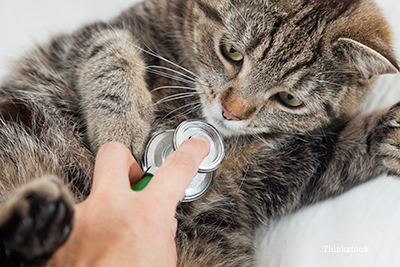
Hyperthyroidism, like many diseases of cats can be somewhat unclear in onset. Clinical signs, according to Washington State University, can sometimes be clear and other times are very hard to evaluate.
[Editor’s Note: Click here for a basic explanation of hyperthyroidism or continue reading to learn how your veterinarian may test for it.]
Is my cat hiding hyperthyroidism?
Sometimes, symptoms of hyperthyroidism will be so subtle they will be missed entirely. In those cases, the disease is often caught because a cat is considered to be at risk due to age. As a result, tests are run to prove or disprove an abnormal thyroid level. A diagnosis of hyperthyroidism is made when the level of thyroid hormone is increased in the blood. Most hyperthyroid cats have very high levels of hormone but some cats will have signs of hyperthyroidism with normal or only slightly increased levels of thyroid hormone1.
How will my veterinarian check my cat’s thyroid?
Your veterinarian will start with a thorough, physical examination and will probably weigh your cat--most cats will lose significant amounts of weight. Your veterinarian will listen carefully for abnormal heart rate and rhythm. Cats with hyperthyroidism, typically, have a rapid heart rate and many will have an abnormal heart rhythm. In most cats, an enlarged thyroid gland(s) can be palpated in the neck alongside the trachea. This enlargement is always present but may not always be palpated.
Diagnosing hyperthyroidism
Diagnosing hyperthyroidism will require blood tests to measure the levels of thyroid hormones (T4) in your cats’ blood. Most cats will have a significantly elevated T4 level2. In cats with borderline or high normal T4 levels, a free T4 test may be done to confirm the disease. Additionally, T4 measurements will need to be done periodically after treatment to determine success, adjust therapy if necessary and to rule out relapses.
Scintigraphic imaging of the thyroid gland may be performed before treatment but is not generally needed to obtain a diagnosis2. In short, the diagnosis of hyperthyroidism is generally straight forward.
Should my cat be screened for thyroid disease?
According to Washington State University, only 5% of cats with hyperthyroidism are younger than ten years of age. Screening T4 tests should be performed routinely in cats over seven yrs of age to facilitate early diagnosis. The majority of cases occur in cats over thirteen2.
If your veterinarian thinks your cat is at risk, he will advocate for tests to evaluate your cat completely.
If you have any questions or concerns, you should always visit or call your veterinarian -- they are your best resource to ensure the health and well-being of your pets.
Resources:
- Hines, Ron. "Hyperthyroidism In Your Cat - Its Cause And Its Treatment." Hyperthyroidism In Your Cat - Its Cause And Its Treatment. Web. 14 Aug. 2014.
- "Pet Health Topics." Hyperthyroidism in the Cat. Washington State University, n.d. Web. 14 Aug. 2014.
